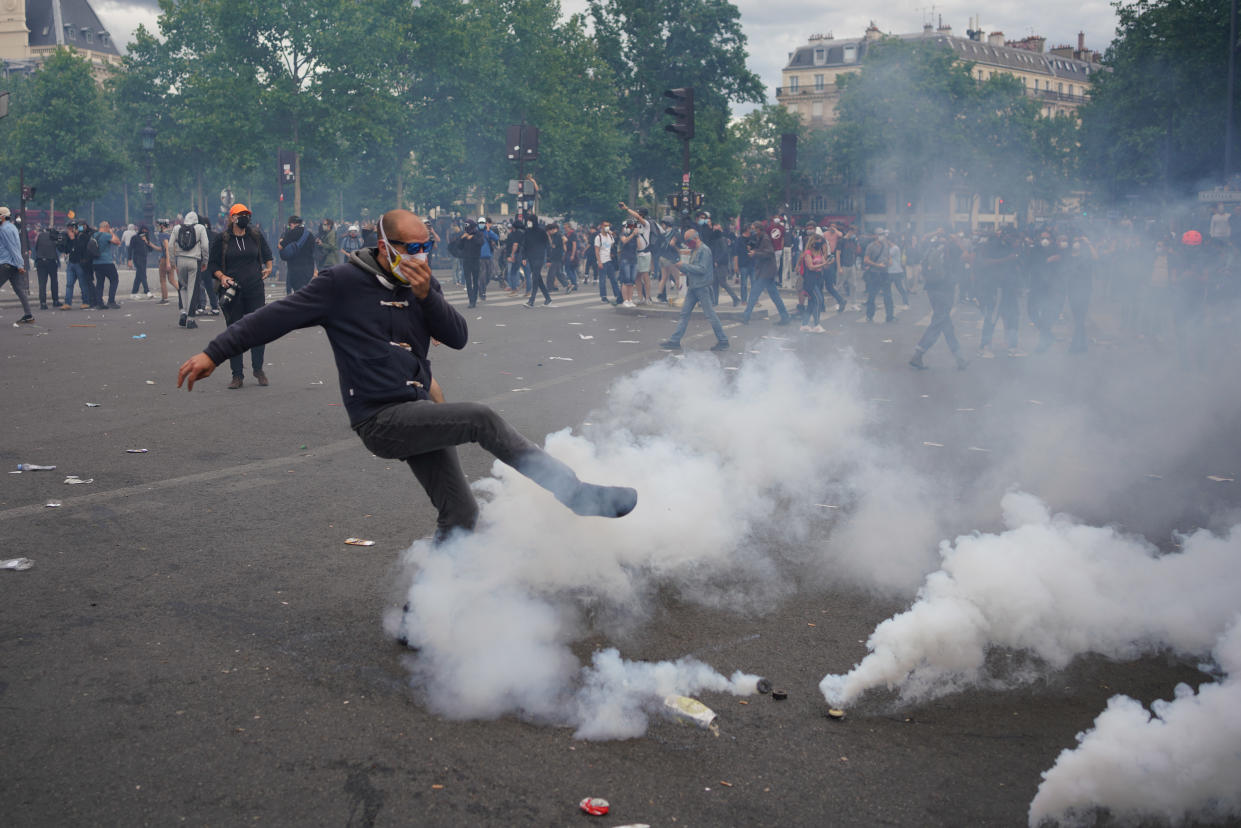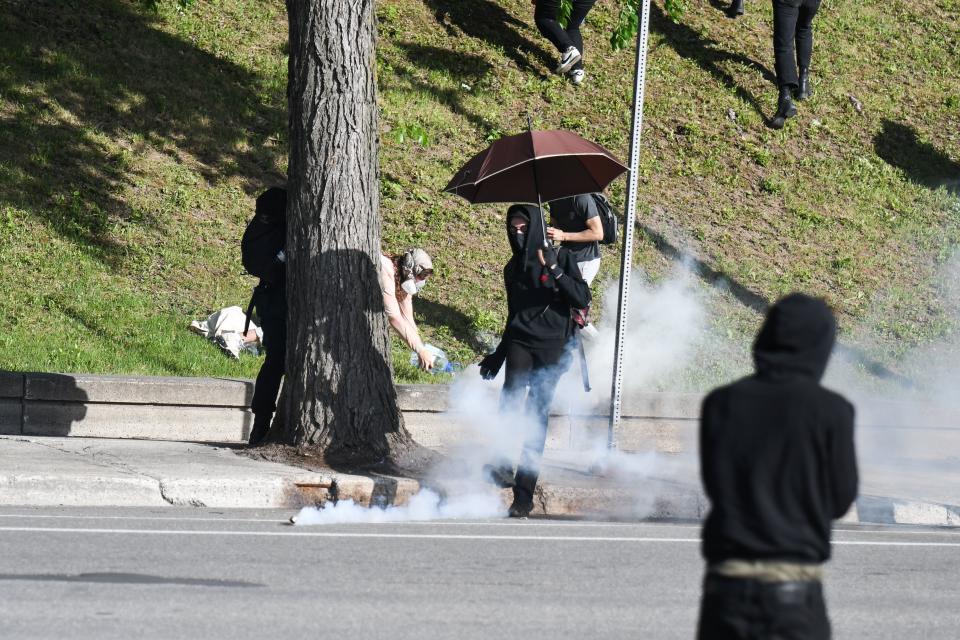Tear gas ‘likely spreads coronavirus by triggering coughing’, warn experts

Police in the US have come under fire for dispersing peaceful Black Lives Matter protests with tear gas.
Events are taking place around the world after George Floyd was murdered when a white policeman knelt on his neck for more than eight minutes.
Officials have urged people not to attend protests out of fear the mass gatherings will cause the highly-infectious coronavirus to spread.
Experts have also expressed concern the use of tear gas to move protestors along “likely” increases the rate of infection by triggering coughing episodes.

Tear gas ‘causes substantial coughing’
Tear gas is made up of chemicals that irritate the mucous membranes.
As a result, the eyes burn, blur and start tearing. Exposed people may also cough, struggle to breathe, develop a burning sensation in their nose and even feel like they are choking.
Although unpleasant, tear gas is generally considered harmless when released at low levels in open spaces.
In confined areas at large doses, however, it has been linked to blindness, respiratory failure, and even immediate death as a result of chemical burns to the throat and lungs.
Exposed people suffer the ill effects almost instantly, however, in mild cases they tend to resolve within several hours.
While no scientific study has been carried out proving tear gas helps spread the coronavirus, a poll by the artificial intelligence tech firm CREOpoint reveals that many experts are concerned.
The company asked hundreds of scientists from Harvard to the University of Cambridge their opinion on tear gas use amid the pandemic.
The overall consensus was it “likely” aids the spread of infection, with more than four in 10 (41%) saying it was “very likely” and a third (33%) believing it is “likely”.
“Tear gas causes substantial coughing, and that increases the potential for virus dissemination and transmission,” said Dr Michael Osterholm, from the University of Minnesota.
The coronavirus mainly spreads face to face via infected droplets expelled in a cough or sneeze.
A dry persistent cough is one of the tell-tale symptoms, along with fever and a loss of taste or smell.
Anyone showing signs of the infection has been told to stay at home entirely.
Asymptomatic patients, however, are free to go out, unwittingly infecting others.
“Tear gas is definitely going to make people cough and sneeze,” said Dr Dean Winslow, of Stanford Health Care.
“I would certainly discourage law enforcement from using those sorts of riot control techniques.”
Tear gas ‘increases the risk of respiratory illnesses’
Professor Jeffrey Duchin, from the University of Washington, said he “opposes the use of tear gas and other respiratory irritants based on the potential to increase COVID-19 spread”.
COVID-19 is the respiratory disease that can be triggered by the coronavirus.
Several experts have written an open letter to US authorities calling for tear gas to be banned amid the pandemic.
Dr Peter Chin-Hong, from the University of California, San Francisco, is even concerned the discomfort of being exposed to the chemical irritants may lead to the coronavirus spreading further still.
“It’ll cause people to shout and scream, propelling droplets of these fluids – which could be carrying coronavirus – and giving them superpowers to spread much farther than six feet (two metres)”, he said.
Infection risk aside, tear gas may worsen complications in those carrying the coronavirus.
In 2014 scientists from the Uniformed Services University of the Health Sciences, Maryland, found exposure raised the odds of catching flu, another respiratory virus.
It also increased the risk of pneumonia, one of the main complications of the coronavirus.
“Having tear gas sprayed on to you is like someone smoking into your lungs,” Dr Chin-Hong told The Guardian. “It’s like any other pollution and like pollution it can increase the risks of respiratory illnesses.”
Not everyone is convinced, however.
Professor Janice Chambers, from Mississippi State University, told The Conversation: “If the tear gas exposure was brief, the individual involved was healthy to begin with, and the resulting irritation subsided quickly, it is logical to assume vulnerability to the novel coronavirus would not be increased”.
She added, however, “there is no precedent or history to inform us”.
This follows 2017 research by scientists at the University of California, Berkeley, who found rubber or plastic bullets used for crowd control can be life-threatening.

What is the coronavirus?
The coronavirus is one of seven strains of a virus class that are known to infect humans.
Others cause everything from the common cold to severe acute respiratory syndrome (Sars), which killed 774 people during its 2002/3 outbreak.
Since the coronavirus outbreak was identified at the end of 2019, more than 8 million cases have been confirmed worldwide, according to Johns Hopkins University.
Of these cases, over 3.8 million are known to have recovered.
Globally, the death toll has exceeded 437,100.
Although the coronavirus mainly spreads via coughs and sneezes, there is also evidence it is transmitted in faeces and can survive on surfaces.
The infection has no “set” treatment, with most patients naturally fighting it off.
Those requiring hospitalisation are given “supportive care”, like ventilation, while their immune system gets to work.
Officials urge people ward off infection by washing their hands regularly and maintaining social distancing.
Coronavirus: what happened today
Click here to sign up to the latest news, advice and information with our daily Catch-up newsletter
Read more about COVID-19
How to get a coronavirus test if you have symptoms
How easing of lockdown rules affects you
In pictures: How UK school classrooms could look in new normal
How public transport could look after lockdown
How our public spaces will change in the future
Help and advice
Read the full list of official FAQs here
10 tips from the NHS to help deal with anxiety
What to do if you think you have symptoms




